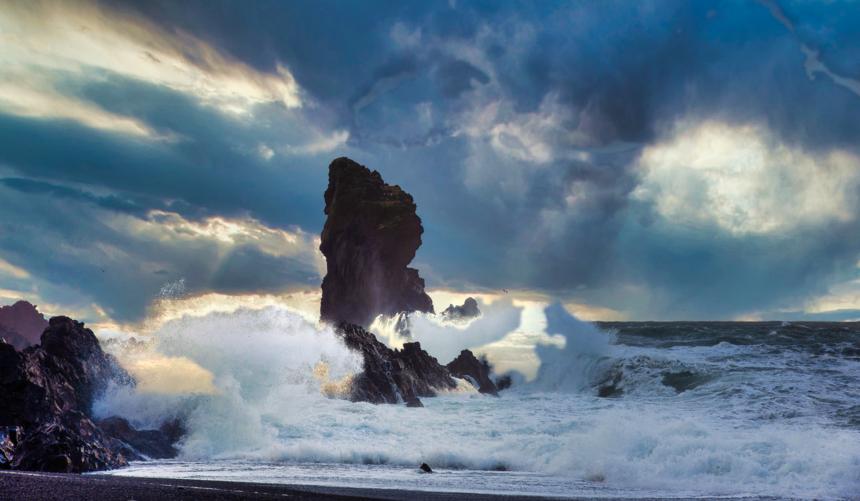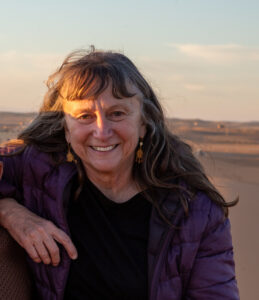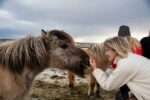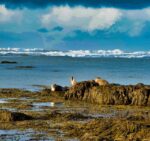By Ava Kabouchy – Photography & Travel Website
There are many ways to travel and explore a different country. To fulfil a childhood dream of experiencing the northern lights, the aurora borealis, Ava Kabouchy visited Iceland as a volunteer and participated in environmental projects. Between whale spotting, trash collection, photography lessons and snow hiking, she learned more about Iceland than on a traditional holiday. Here’s her inspirational account:
It all started with Sister Adelaide
When Sister Adelaide told us eight-year-old third graders about the aurora borealis in geography class at St. Brigid’s School in North Bergen, New Jersey so many years ago, I was enthralled at the idea of the night sky lighting up in green. In my class photo that year, I was wearing a glass pendant cut like prism to show all the colours of the light. I called it my ‘aurora borealis’ necklace, and wondered if someday I would see the aurora for real.
A different kind of trip to Iceland

But my trip to Iceland wasn’t only about seeing the aurora; it was also about joining a workcamp organized by SEEDS, an NGO based in Reykjavik, which organizes workcamps for international volunteers to live and work together on a project that has been identified by a local community. Projects mainly focus on nature, such as building hiking trails or walking paths, and participating in reforestation, or are focused on the environment as my workcamp was. Impossible to spend extended amounts of time outside in mid-March in Iceland, we workcamp participants in the Environmentally Aware and Trash Hunting Project, did two clean-up projects in Reykjavik.
(SEEDS is affiliated with SORPA, a community-based organization is in charge of waste collection and management in the Reykjavík area with other local stakeholders. Organic kitchen waste, mixed household waste, paper and cardboard, and plastic packaging are all carefully managed as a result of citizen concern)
We volunteers were amazed to discover how many bits of plastic especially we collected on and under the melting snow along streets in Reykjavik. Two volunteers were needed to carry the heavy burlap bag into which we had all put our found pieces, including a very large number of cigarette butts. The clean-up reminded all of us how quickly and easily small pieces of plastic and other trash accumulate and what harm is being done to the environment, in addition to the unsightliness of it all. A cigarette butt can take from eighteen months to ten years to decompose and we had picked up many.
Plans to participate in a food distribution program, unfortunately, had to be cancelled because bad weather prevented food from being delivered to its destination. A strong fishing industry exists in Iceland and only 2.5% of the population faces hunger, a remarkable statistic that has not increased since 2000. However, single mothers and those unemployed because of the covid pandemic remain the most vulnerable populations, for whom the food was intended.
Ég tala ekki íslensku

One afternoon after our second collection of trash and disposing of it, we were invited to an Icelandic language course for a large group of immigrants and refugees faced with learning a language that must be exceedingly difficult to learn. The teacher provided learners with many different teaching modalities – a short video of a family at dinner, a song about the days of the week and months of the year, and teacher to student questions. People in the course came from many parts of the world, and as I looked at two Muslim women, possibly refugees from Iraq, I wondered how they had managed to get to Iceland, but even more so, how they were adjusting to such an extreme change of culture and climate. Most of the students kept their winter coats and hats on even though the room was very warm while outside frequent snow squalls were still happening in March.
We volunteers were treated to a one-hour language class just to learn simple phrases, none of which could I remember as the teacher practiced with our small group: Where do you live? Hvar býrðu? I don‘t speak Icelandic: Ég tala ekki íslensku. Fortunately for the group, our common language was English.
Purposeful projects

All of our days with SEEDS were filled with activities, which included after-dinner workshops on photograph composition, lighting, and editing. Each of the volunteer instructors gave us assignments such as composition and then we spent time taking photographs, sending them to the instructor, and having them critiqued within the group. After our final dinner together, each participant showed ten of her best photos, and many of them were truly excellent.
Another activity was a visit to the Whales of Iceland exhibition with life-size creations of whales and facts about each one. A film was shown of the many different species of whales, which included whale song to which we listened while sitting comfortably on large pillows on the floor. The exhibition is educational, reminding people of the impact humans have on the existence of whales. At the residence we viewed a video about dying coral reefs in Australia, the Florida Keys, and other places where the 1.1⁰C degree rise in temperature of the water, caused by global warming, has all but put an end to the reefs in the Keys, now bleached white because of the lack of life within them.
Geothermal power

If you aren‘t an engineer or a scientist, you might not find a visit to a geothermal plant interesting, but this was Iceland, which uses imported oil only for transportation and fishing, one of its main natural resources. We learned at the Hellisheiði Power Plant that during 1940 to 1975, Iceland began using geothermal, a renewable energy source.
Amazingly, 73% of Iceland‘s electricity is produced by hydropower plants and almost 27% is produced by geothermal energy. When a drill is put into the ground near one of Iceland‘s nearly 600 hot springs, the steam is used to run the turbines which distribute the hot water to towns and cities. The temperature of the steam is 180C/356F. Electricity is produced by hydro-power, and 70% of the country‘s energy consumption is from renewable sources, a remarkable statistic.
The beauty of Iceland. It really is all it is cracked up to be

After visiting the plant, our young driver and guide from Portugal, Luis, a helpful long-term volunteer, drove us to the Geysir Geothermal Area to see some of the geysers which provide the country‘s hot water for heating homes and other spaces. We saw steaming fumaroles caused by the boiling water which runs just a few feet beneath the earth‘s surface and the geyser, which regularly shoots steam and boiling water high into the air. (Geysir is actually an Icelandic word, which has become a word used internationally.) Nearby was the Gullfoss Waterfall, giving us an idea of the power of hydropower, a spectacular sight under a blue sky where everything else was pure white. We hiked along the rim of the Burfell Crater and looked down at the frozen lake in the crater below us, strong winds howling around us.
On our way back to Reykjavik, we spotted a small herd of Icelandic horses – small but strong animals with a double coat to keep them warm in the very long and harsh winter. Brought to Iceland by the Vikings in the 8th century, the horses by law cannot be imported in order to keep the breed pure and disease free. If an Icelandic horse is exported, it is not allowed to come back. And they are very friendly to visitors.
Volcanic cliffs, howling winds, whale spotting and snow hiking

Our second excursion took us to Snaefellsnes National Park, located on a peninsula in west Iceland where March winds blowing over the cliffs made us tread carefully as we watched high surf crashing against the volcanic cliffs. And as we watched, we saw the back of a whale emerge, an amazing site, which was like a gift from nature to us. Earlier we had walked to a beach where we saw numerous seals sunning themselves on lava rocks in the ocean. On the beach was the skeleton of the spine of a whale.

And as if those sights hadn‘t been enough, we then hiked in the snow to a cave in the blue and white landscape to see a river flowing within it. From there we hiked down to a black sand beach bordered by black volcanic monoliths protruding out of the white snow and others standing in the sea, being battered by high winds and high seas. The sun came out and went away, a snow squall came and went away. The day continued with a visit to an 18th century church seemingly in the middle of nowhere, with no houses to be seen, and only a small cemetery next to the church . We were driven onward where blue was the dominant colour, a cold blue, no other vehicles in sight as light snow continued to fall.
As our van approached Kirkjufell Mountain, its iconic beauty could be seen even from a distance. High and looking much like a peaked hat, some snow still covered it and below it two waterfalls cascaded.
Reflections on a different kind of visit to Iceland

Of course you can visit the Blue Lagoon and Skogafoss Waterfall and Seljalandsfoss Waterfall, behind which you can walk, and sleep in the bubble hotel waiting for the aurora to appear at any moment in the night sky. But this was a different kind of Icelandic experience.
I left feeling admiration for the young program participants, all young women by chance from Italy, Greece, France, Mexico, Germany, Portugal, and the U.S. ranging in age from 17 to 23 (if you don’t count the participant from the U.S. who was somewhat older.) Some had just finished high school and were doing a gap year to travel not only as tourists, but as young women interested in organizations such as SEEDS and the environmental work it is doing. Some were already enrolled in university, or had finished university, and were taking a gap year for the same reason.
Their interests were in developmental economics and humanitarian work, art, business start-ups, medicine, and medical research. Not admiring their enthusiasm for their time in Iceland along with their future plans and goals was impossible. During meal prep or just sitting in the common area, I talked with some of these young women and admired their independence, their plans for their futures, and their concerns about the environment and what could be done to keep it clean and bring it back to health.
Concern exists among Icelanders and its government that over-tourism is harming the country’s fragile environment. Justin Bieber, who produced a video in the valley where the Skogafoss and Seljalandsfoss Waterfalls are located, brought so much tourism to that area that the government had to close it for a while. Bieber‘s antics, such as skateboarding atop a crashed plane and rolling down a moss-covered hill were being imitated by tourists, causing not only danger to themselves but to the environment – moss can take up to 70 years to grow and it was being destroyed.
Swimming outside while it was snowing

We spent our last full day talking and relaxing in the common living room. I had heard about the outdoor thermal pools nearby and decided that would be a great way to spend my last afternoon in Reykjavik. A short distance to walk in the snow, I went into one of the pools where people sat in water, geothermically heated of course at a temperature of 44C/110F.
When it felt it was time for a swim, I walked in the cold to the large lap pool where the water was comfortably and naturally heated, did some laps, then returned to the sitting pool. The air temperature was 2C/33F, and it was snowing. I looked up at the snow and marvelled at what I was experiencing – being outside in Iceland in the snow and in naturally heated pools. Back for some laps, back to warm up in the pool, more laps…
As I walked back to the house, refreshed and relaxed, it was snowing, a gentle snow this time, not a squall.
Back to Sister Adelaide

I did see the aurora borealis. Getting out of the van with seven other people on a very cold and very windy March night in Kleifarvatin, the dream of an enthralled eight-year-old came to life. I put my gloved hands over my face and just stared upwards. Green lights in the sky just as I had imagined them, different sizes and shapes, shades of light green and darker green. They would disappear. They would return. Fourth of July fireworks could never have compared. This was natural, this was nature at her finest.
I remember Sister Adelaide’s long Dominican habit and wimple, which covered her face. When we third graders became fifth graders, we heard a rumour that Sister Adelaide had left the convent, which didn’t surprise any of us because we could just how pretty she was. Today I wonder if all those years ago if Sister Adelaide was enthralled by the vision of the aurora borealis and that she, too, saw it as I did and experienced the wonder of green lights dancing in the northern skies.
- Seals sunning themselves along the coast abefore another snow squall returns
Interesting facts about Iceland
Beer was illegal until 1989. Iceland has no military – no air force, no army, no marines.
Getting there
Well-priced tickets on Icelandic Air, very fast and efficient check in. Flybus at the airport makes many stops. Just tell the driver the name of your hotel.
Where to stay
Nupan Deluxe near Keflavik Airport; perfect place to rest before your trip home, €59 a night, about $64.
Where to eat
You have many choices in the centre of Reykjavik.
SEEDS Volunteer program
If you are interested in volunteering with SEEDS in Iceland, here is the website: https://www.seeds.is/workcamps
I found SEEDS through CADIP.org, which offers numerous volunteer opportunities around the world. There is no upper age limit.

About Ava Kabouchy
 As a child, Ava was fascinated by world maps, which later turned into travels to many parts of the world. She has worked in several African countries, created a microcredit group for women in Honduras, and did a volunteer photography gig for a clinic for a Mayan community in a remote mountainous region of Guatemala. Recently, she hiked along the Camino de Santiago in Spain and in France, travelled in Morocco, fulfilling a childhood dream of walking barefoot in the Sahara and another of seeing the aurora borealis in Iceland.
As a child, Ava was fascinated by world maps, which later turned into travels to many parts of the world. She has worked in several African countries, created a microcredit group for women in Honduras, and did a volunteer photography gig for a clinic for a Mayan community in a remote mountainous region of Guatemala. Recently, she hiked along the Camino de Santiago in Spain and in France, travelled in Morocco, fulfilling a childhood dream of walking barefoot in the Sahara and another of seeing the aurora borealis in Iceland.
Ava is the author of the recently published “Where in the World is Grammie Now?”, a book for young readers to teach them about Saudi Arabia, a country not often studied in middle school curricula. She has also authored a book on her four years in Saudi Arabia: “Wanderlust, A New Lease on Life in the Kingdom of Saudi Arabia”.
Ava makes her home in southwest France and on a remote island off the coast of Maine, USA.
Find out more about Ava Kabouchy on her website.







